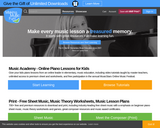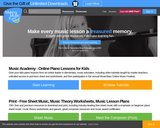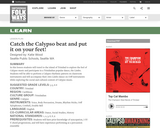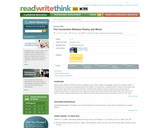
Students will be able to effectively recognize and imitate AB binary form through movement.
- Subject:
- Arts Education
- Music
- Material Type:
- Lesson Plan
- Provider:
- Teachers.Net
- Author:
- Meghan Webb
- Date Added:
- 02/26/2019

Students will be able to effectively recognize and imitate AB binary form through movement.

Students will listen to Copland's Appalachian Spring while listening to a reading of Heartland by Diane Siebert. They will then write their own poems and create accompanying artwork.

Students will use the San Francisco Symphony's Kids website to choose music that supports the events and people associated with the history of Oklahoma, such as Native Americans explorers and exploration; Civil War; Trail of Tears; Land Run; and farmers, and ranchers. Students will write two or three sentences to explain and support their selection of music. In small groups, students will create a statue or tableau depicting one of the events. Students will perform a tableau for the class with their musical selection as a background.

Students will discover how the love of music connected two important figures in world history: Benjamin Franklin, an American founding father, and Wolfgang Amadeus Mozart, an Austrian composer. Additionally, students will begin to understand pitch, and how each note is calibrated to create its own unique sound.

Students will generate descriptive language of several animals (with special focus on verbs), culminating in the writing of a poem about the animal of their choice. Use Saint-Saens' Carnival of the Animals as a stimulus prompt.

Students will learn about Italian artist Giuseppe Arcimboldo, his mannerist style, and his four paintings named after the four seasons. Students will learn about the food groups and the four seasons. Students will learn about Italian composer Antonio Vivaldi and his compositions named after the four seasons.

Students work in groups to learn and perform a piece on non-pitched percussion instruments and develop rhythm reading and ensemble skills.

Students will gain an understanding of meter by experiencing accented and unaccented beats. This free lesson plan is designed to fulfill Standard #5 of the National Standards for Music Education: Reading and notating music.

This lesson develops students' ability to hear subtle dynamic levels in orchestral music, and to recognize
sudden and gradual differences. They will use their collective perception to make relative aural judgments
about levels and changes. Data will be recorded on a bar graph marking real time and 6 dynamic levels
roughly equivalent to 6 primary markings of standard dynamics: pp to ff.

Students discover how music can create a visual image in one"™s mind as they listen to Beethoven"™s Sixth Symphony "“ Pastoral. As the image takes shape, the students create a visual representation of their image to include the aspects of nature which Beethoven included in this wonderful composition.

Students write a descriptive essay explaining their thoughts and feelings while listening to Beethoven"™s 5th Symphony, learning how to describe the musical elements that cause them to feel this way, and transpose these feelings into a watercolor art piece. The students will present their essay and art work orally, and act out their responses during a physical education exercise.

Students will complete two language arts activities for this lesson. In the first activity, students use folk
songs from the era of the California Gold Rush, which are introduced in the early chapters of By the Great
Horn Spoon! by Sid Fleishman, to identify folk song motifs in the classical music of AntonÃn Dvořák. This
will be explored by the students' creation of a labeled line drawing of one of Dvořák 's compositions. In the second activity, students will write a letter to Dvořák from the point of view of Master Jack, a character in Fleishman"™s novel, inviting Dvořák to continue his American tour into the gold fields of California for
musical inspiration.

Students will explore creating moods with music. Students will assimilate this new knowledge through the analysis of a story and the creation of a musical composition that reflects and enhances it. This activity will culminate with the recording of their musical accompaniment and story to produce a book on tape.

Students will travel to the island of Trinidad to explore the feel of Calypso music and participate in a Trinidadian popular dance, the Limbo. Students will be able to perform a Calypso rhythmic pattern on classroom instruments and will accompany their own Limbo dance on Orff instruments while exploring the social and cultural context of Calypso music.

Students are introduced to Johann Sebastian Bach"™s music through short deep listening exercises and
optional integrated language arts activity.

This lesson introduces basic communication skills by asking the following questions: "What does communication mean? What do good communicators do? Selections from Fanfare for the Common Man Fanfare for the Common Man by Aaron Copland and Carnival of the Animals by Camille Saint-Saëns will help us define musical terms and discover the answers to our questions.

In this lesson, students listen to poems read aloud, and they discuss the rhythm and sound of poetry. Students then perform poems using musical instruments to emphasize cadence. Using online tools, they learn about line breaks and the way these affect the rhythm of a poem. Finally, students write poems they believe will be enhanced by music and perform them for the class.

To accomplish goals, members of families must cooperate, just as members of the orchestra must cooperate to create beautiful music. Similarly, students in a classroom have similar constructs; everyone must do their best for themselves as well as for the good of the whole. This lesson helps students understand that an orchestra, a family, and a classroom must work together to accomplish great things.

Why do two composers from the same period of history compose different music? Students will gain an understanding of how culture and history influences music as they analyze and compare the music of Aaron Copland and Duke Ellington, and learn how these composers used special sounds to enhance their music.

This lesson uses Aaron Copland's Billy the Kid as a stimulus for creative thinking. The students will listen to Copland's Billy the Kid, listening for changes in tempo and dynamics. Then the students will create an abstract painting, and describe the tempo and dynamics they heard in a written composition.